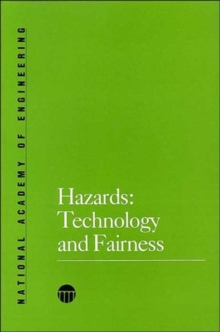"In the burgeoning literature on technological hazards, this volume is one of the best," states Choice in a three-part approach, it addresses the moral, scientific, social, and commercial questions inherent in hazards management.
Part I discusses how best to regulate hazards arising from chronic, low-level exposures and from low-probability events when science is unable to assign causes or estimate consequences of such hazards; Part II examines fairness in the distribution of risks and benefits of potentially hazardous technologies; and Part III presents practical lessons and cautions about managing hazardous technologies.
Together, the three sections put hazard management into perspective, providing a broad spectrum of views and information. Table of ContentsFront MatterINTRODUCTION: EMERGING ISSUES IN HAZARD MANAGEMENTREFERENCEPART 1 UNCERTAINTYScience and Its Limits: The Regulator's DilemmaSCIENCE AND RARE EVENTS"Scientific" Approaches to Rare EventsLow-Level ExposureHow Science Reacts to Intrinsic UncertaintyTHE ATTACK ON SCIENCE FROM THE SOCIOLOGY OF KNOWLEDGETechnological FixThe De Minimis PrincipleCONCLUSIONSREFERENCESCausality of a Given Cancer After Known Radiation ExposureACCIDENTAL HARM IN POPULATIONS OF EXPOSED PERSONSQUANTAL RESPONSE IN A POPULATION OF HARMED PERSONSRADIOTHERAHY OR ACCIDENTAL HIGH-LEVEL RADIATION EXPOSURELOW-LEVEL EXPOSURE OF NORMAL POPULATIONSRADIOBIOLOGICAL RESPONSE FUNCTIONSPROBABILITY OF CAUSATION IN CANCER CASESReferencesDealing With Uncertainty About Risk in Risk ManagementRisk Assessment PolicyIs Conservatism Protective?The Social Costs of ErrorResource Constraints and Risk ManagementRisk TransfersCONSERVATISM IN RISK ASSESSMENT: COMMENTSDE MINIMIS RISKDe Minimis Risk and Conflicting Social ObjectivesIndividual Versus Societal Definition of De Minimis RiskApplying the De Minimis ConceptReferencesScientists, Engineers, and the Burdens of Occupational Exposure:The Case of the Lead StandardBACKGROUND OF THE OSHA LEAD STANDARDHEARINGS ON THE OSHA STANDARD: SCIENCE, POLITICS, AND THE CLASH OFINTERESTSTHE FINAL LEAD STANDARDCONCLUSIONSReferencesPART 2 EQUITY AND COMPENSATIONHypersusceptibility to Occupational HazardsHYPERSUSCEPTIBLE GROUPSSCREENING AND MONITORINGFAIRNESSReferencesThe Bhopalization of American Tort LawBipolarityTimelinessThe Driving ForceCAN THE LEGAL SYSTEM COPE?Regressive IncentivesKindling the FlamesThe Writing on the WallInstitutional CompetenceDeferring to the ExpertsCompensating VictimsPUBLIC RISKS AND POLITICAL LEGITIMACYNOTESReferencesTHE PRINCIPLE OF FORESEEABILITYFire and Wind CasesProduct Liability CasesTHE PRINCIPLE OF JOINT AND SEVERAL LIABILITY WITHOUT CONTRIBUTIONNew Determinants of DutyMandatory Allocation of Damages Among Responsible PartiesReferencesHazardous Waste Facility Siting: Community, Firm, and GovernmentalPerspectivesThe Need for a Systems ApproachRisk UncertaintyPublic Perception of RiskEquity and the Ethics of Risk ImpositionInstitutional DistrustCommunicating Risk to the PublicProblem and Institutional MismatchApproach 1: Locational OpportunismApproach 2: Imposition by Central AuthorityApproach 3: Bartered ConsentApproach 4: Fairness-Centered ProcessConceptualizing the Siting ProblemAn Ethical Base for SitingRisk Reduction and Safety AssuranceThe Role of CompensationReferencesHazard Compensation and Incentive Systems: An Economic PerspectivePROBLEM CHARACTERISTICSDESIGNING INCENTIVE SYSTEMS FOR PROTECTIVE ACTIVITIESBroadening the Time HorizonPenalties and FinesCOMPENSATION IN SITING TECHNOLOGICAL FACILITIESWes-Con, Inc. Wes-Con, Inc. Self-Insurance FundsIntegrating Stakeholders and StagesEliciting Preferences for CommunitiesCONCLUSIONSReferencesPART 3 MANAGING TECHNOLOGICAL HAZARDSEconomic, Legal, and Practical Problems in Hazardous Waste Cleanupand ManagementHOW CLEAN IS CLEAN?Harris CorporationSapp Battery SalvageJacksonvilleWhitehouse Oil PitsTower ChemicalLiability InsuranceCleanup DelaysSovereign ImmunityPRACTICAL PROBLEMSPROSPECTS FOR LONG-TERM MANAGEMENTNational Small-Quantity Generator SurveyAmnesty DaysThe Case for Transfer StationsAnother Alternative: IncinerationCONCLUSIONFocusing Private-Sector Action on Public HazardsCLEAN SITES INC.: GOALS AND ORGANIZATIONWHAT CAN CLEAN SITES INC.
DO?DIRECTIONS FOR THE FUTUREReferencesThree Mile Island and Bhopal: Lessons Learned and Not LearnedLESSONS FOR INDUSTRYLESSONS FOR REGULATORSTHE PUBLICSCIENTISTS AND ENGINEERSReferencesManaging Technological Hazards: Success, Strain, and SurpriseINSTITUTIONS OF HAZARD MANAGEMENTTHE PERSISTENCE OF SURPRISELIMITS TO HAZARD MANAGEMENTTECHNOLOGICAL AND BEHAVIORAL FIXESSHIFTING ATTITUDES, INSTITUTIONS, AND ACTIVITIESACKNOWLEDGMENTSReferencesABOUT THE AUTHORS

